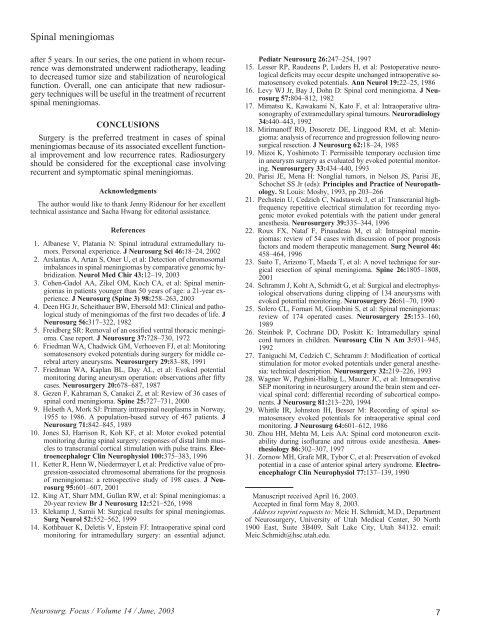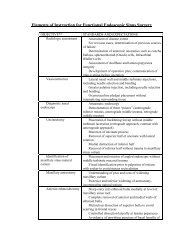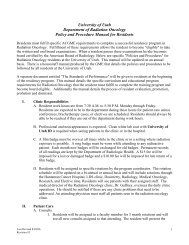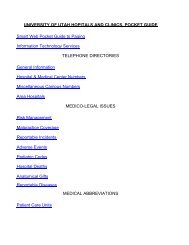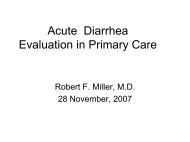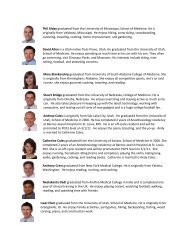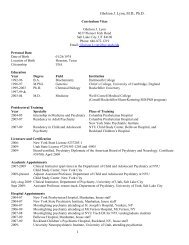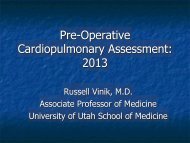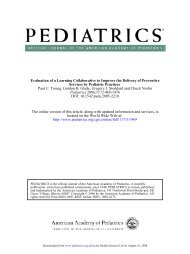Spinal meningiomas: surgical management and outcome
Spinal meningiomas: surgical management and outcome
Spinal meningiomas: surgical management and outcome
Create successful ePaper yourself
Turn your PDF publications into a flip-book with our unique Google optimized e-Paper software.
<strong>Spinal</strong> <strong>meningiomas</strong><br />
after 5 years. In our series, the one patient in whom recurrence<br />
was demonstrated underwent radiotherapy, leading<br />
to decreased tumor size <strong>and</strong> stabilization of neurological<br />
function. Overall, one can anticipate that new radiosurgery<br />
techniques will be useful in the treatment of recurrent<br />
spinal <strong>meningiomas</strong>.<br />
CONCLUSIONS<br />
Surgery is the preferred treatment in cases of spinal<br />
<strong>meningiomas</strong> because of its associated excellent functional<br />
improvement <strong>and</strong> low recurrence rates. Radiosurgery<br />
should be considered for the exceptional case involving<br />
recurrent <strong>and</strong> symptomatic spinal <strong>meningiomas</strong>.<br />
Acknowledgments<br />
The author would like to thank Jenny Ridenour for her excellent<br />
technical assistance <strong>and</strong> Sacha Hwang for editorial assistance.<br />
References<br />
1. Albanese V, Platania N: <strong>Spinal</strong> intradural extramedullary tumors.<br />
Personal experience. J Neurosurg Sci 46:18–24, 2002<br />
2. Arslantas A, Artan S, Oner U, et al: Detection of chromosomal<br />
imbalances in spinal <strong>meningiomas</strong> by comparative genomic hybridization.<br />
Neurol Med Chir 43:12–19, 2003<br />
3. Cohen-Gadol AA, Zikel OM, Koch CA, et al: <strong>Spinal</strong> <strong>meningiomas</strong><br />
in patients younger than 50 years of age: a 21-year experience.<br />
J Neurosurg (Spine 3) 98:258–263, 2003<br />
4. Deen HG Jr, Scheithauer BW, Ebersold MJ: Clinical <strong>and</strong> pathological<br />
study of <strong>meningiomas</strong> of the first two decades of life. J<br />
Neurosurg 56:317–322, 1982<br />
5. Freidberg SR: Removal of an ossified ventral thoracic meningioma.<br />
Case report. J Neurosurg 37:728–730, 1972<br />
6. Friedman WA, Chadwick GM, Verhoeven FJ, et al: Monitoring<br />
somatosensory evoked potentials during surgery for middle cerebral<br />
artery aneurysms. Neurosurgery 29:83–88, 1991<br />
7. Friedman WA, Kaplan BL, Day AL, et al: Evoked potential<br />
monitoring during aneurysm operation: observations after fifty<br />
cases. Neurosurgery 20:678–687, 1987<br />
8. Gezen F, Kahraman S, Canakci Z, et al: Review of 36 cases of<br />
spinal cord meningioma. Spine 25:727–731, 2000<br />
9. Helseth A, Mork SJ: Primary intraspinal neoplasms in Norway,<br />
1955 to 1986. A population-based survey of 467 patients. J<br />
Neurosurg 71:842–845, 1989<br />
10. Jones SJ, Harrison R, Koh KF, et al: Motor evoked potential<br />
monitoring during spinal surgery: responses of distal limb muscles<br />
to transcranial cortical stimulation with pulse trains. Electroencephalogr<br />
Clin Neurophysiol 100:375–383, 1996<br />
11. Ketter R, Henn W, Niedermayer I, et al: Predictive value of progression-associated<br />
chromosomal aberrations for the prognosis<br />
of <strong>meningiomas</strong>: a retrospective study of 198 cases. J Neurosurg<br />
95:601–607, 2001<br />
12. King AT, Sharr MM, Gullan RW, et al: <strong>Spinal</strong> <strong>meningiomas</strong>: a<br />
20-year review Br J Neurosurg 12:521–526, 1998<br />
13. Klekamp J, Samii M: Surgical results for spinal <strong>meningiomas</strong>.<br />
Surg Neurol 52:552–562, 1999<br />
14. Kothbauer K, Deletis V, Epstein FJ: Intraoperative spinal cord<br />
monitoring for intramedullary surgery: an essential adjunct.<br />
Neurosurg. Focus / Volume 14 / June, 2003<br />
Pediatr Neurosurg 26:247–254, 1997<br />
15. Lesser RP, Raudzens P, Luders H, et al: Postoperative neurological<br />
deficits may occur despite unchanged intraoperative somatosensory<br />
evoked potentials. Ann Neurol 19:22–25, 1986<br />
16. Levy WJ Jr, Bay J, Dohn D: <strong>Spinal</strong> cord meningioma. J Neurosurg<br />
57:804–812, 1982<br />
17. Mimatsu K, Kawakami N, Kato F, et al: Intraoperative ultrasonography<br />
of extramedullary spinal tumours. Neuroradiology<br />
34:440–443, 1992<br />
18. Mirimanoff RO, Dosoretz DE, Linggood RM, et al: Meningioma:<br />
analysis of recurrence <strong>and</strong> progression following neuro<strong>surgical</strong><br />
resection. J Neurosurg 62:18–24, 1985<br />
19. Mizoi K, Yoshimoto T: Permissible temporary occlusion time<br />
in aneurysm surgery as evaluated by evoked potential monitoring.<br />
Neurosurgery 33:434–440, 1993<br />
20. Parisi JE, Mena H: Nonglial tumors, in Nelson JS, Parisi JE,<br />
Schochet SS Jr (eds): Principles <strong>and</strong> Practice of Neuropathology.<br />
St Louis: Mosby, 1993, pp 203–266<br />
21. Pechstein U, Cedzich C, Nadstawek J, et al: Transcranial highfrequency<br />
repetitive electrical stimulation for recording myogenic<br />
motor evoked potentials with the patient under general<br />
anesthesia. Neurosurgery 39:335–344, 1996<br />
22. Roux FX, Nataf F, Pinaudeau M, et al: Intraspinal <strong>meningiomas</strong>:<br />
review of 54 cases with discussion of poor prognosis<br />
factors <strong>and</strong> modern therapeutic <strong>management</strong>. Surg Neurol 46:<br />
458–464, 1996<br />
23. Saito T, Arizono T, Maeda T, et al: A novel technique for <strong>surgical</strong><br />
resection of spinal meningioma. Spine 26:1805–1808,<br />
2001<br />
24. Schramm J, Koht A, Schmidt G, et al: Surgical <strong>and</strong> electrophysiological<br />
observations during clipping of 134 aneurysms with<br />
evoked potential monitoring. Neurosurgery 26:61–70, 1990<br />
25. Solero CL, Fornari M, Giombini S, et al: <strong>Spinal</strong> <strong>meningiomas</strong>:<br />
review of 174 operated cases. Neurosurgery 25:153–160,<br />
1989<br />
26. Steinbok P, Cochrane DD, Poskitt K: Intramedullary spinal<br />
cord tumors in children. Neurosurg Clin N Am 3:931–945,<br />
1992<br />
27. Taniguchi M, Cedzich C, Schramm J: Modification of cortical<br />
stimulation for motor evoked potentials under general anesthesia:<br />
technical description. Neurosurgery 32:219–226, 1993<br />
28. Wagner W, Peghini-Halbig L, Maurer JC, et al: Intraoperative<br />
SEP monitoring in neurosurgery around the brain stem <strong>and</strong> cervical<br />
spinal cord: differential recording of subcortical components.<br />
J Neurosurg 81:213–220, 1994<br />
29. Whittle IR, Johnston IH, Besser M: Recording of spinal somatosensory<br />
evoked potentials for intraoperative spinal cord<br />
monitoring. J Neurosurg 64:601–612, 1986<br />
30. Zhou HH, Mehta M, Leis AA: <strong>Spinal</strong> cord motoneuron excitability<br />
during isoflurane <strong>and</strong> nitrous oxide anesthesia. Anesthesiology<br />
86:302–307, 1997<br />
31. Zornow MH, Grafe MR, Tybor C, et al: Preservation of evoked<br />
potential in a case of anterior spinal artery syndrome. Electroencephalogr<br />
Clin Neurophysiol 77:137–139, 1990<br />
Manuscript received April 16, 2003.<br />
Accepted in final form May 8, 2003.<br />
Address reprint requests to: Meic H. Schmidt, M.D., Department<br />
of Neurosurgery, University of Utah Medical Center, 30 North<br />
1900 East, Suite 3B409, Salt Lake City, Utah 84132. email:<br />
Meic.Schmidt@hsc.utah.edu.<br />
7


